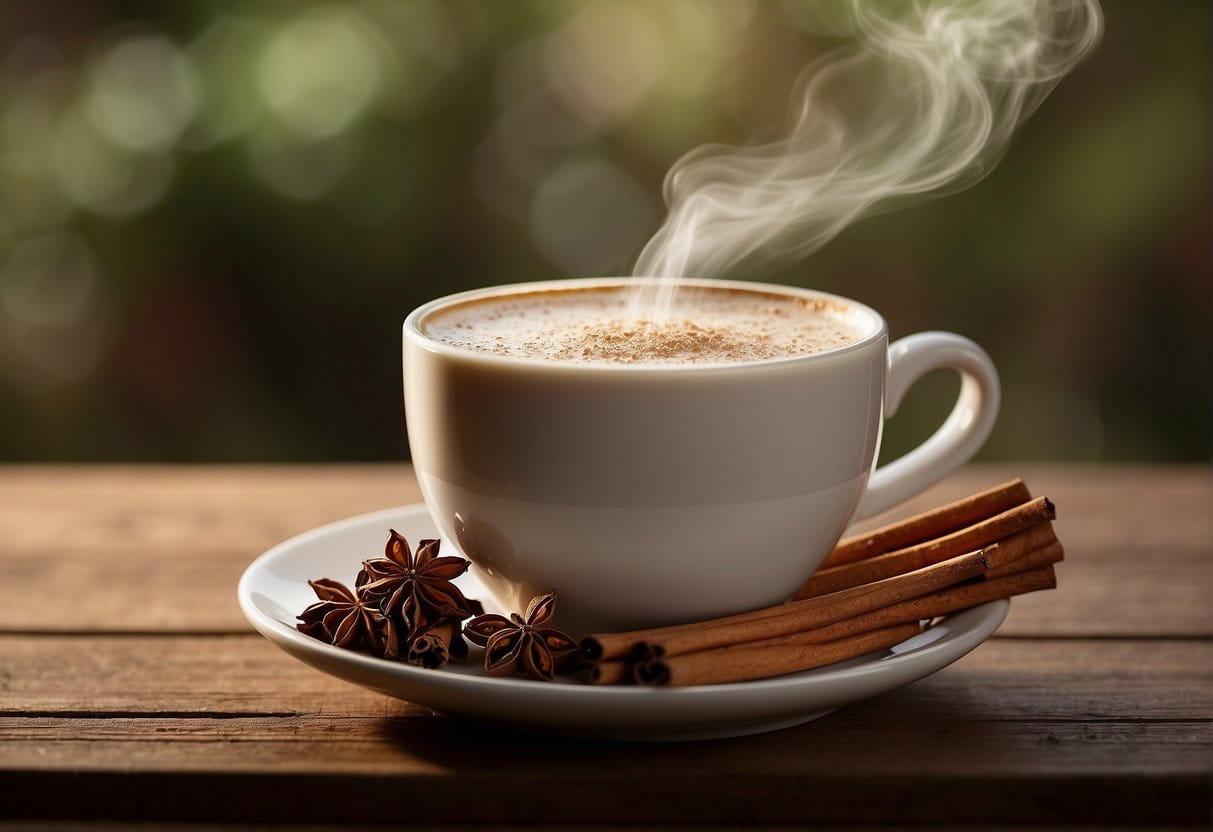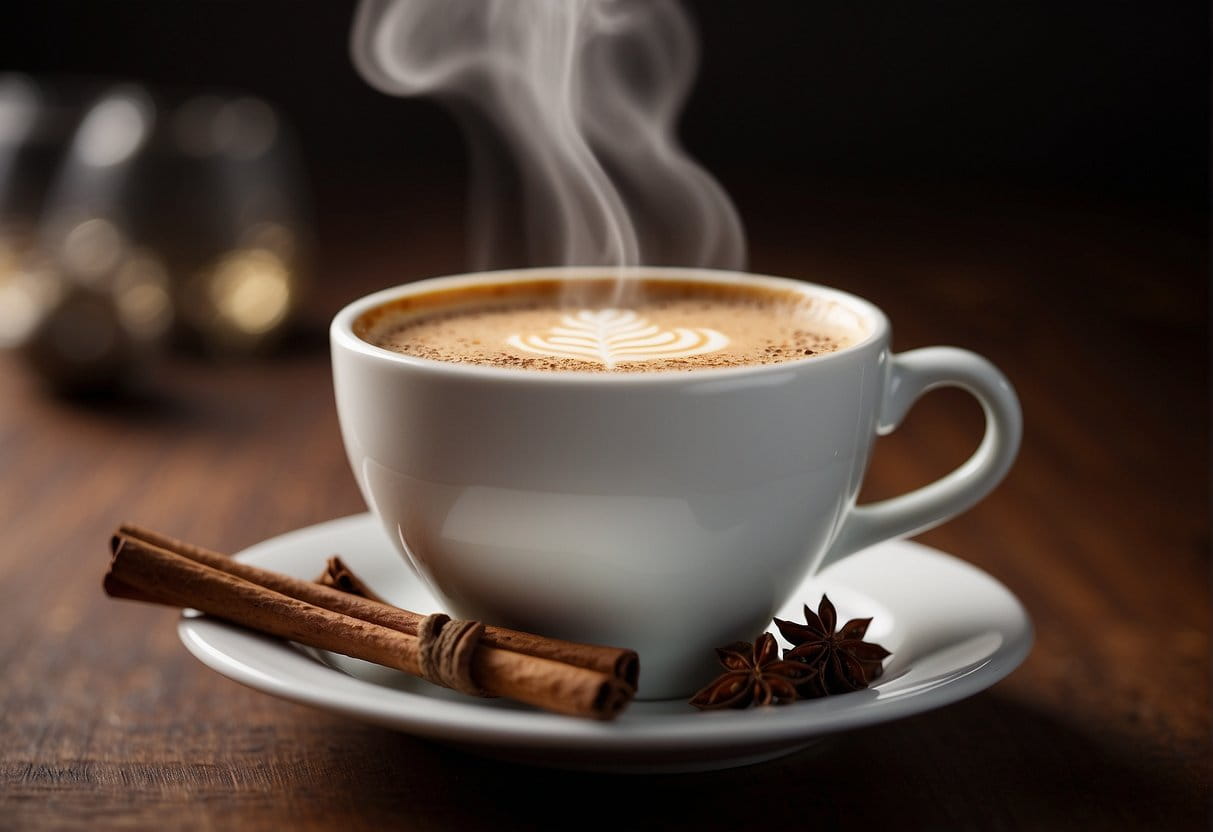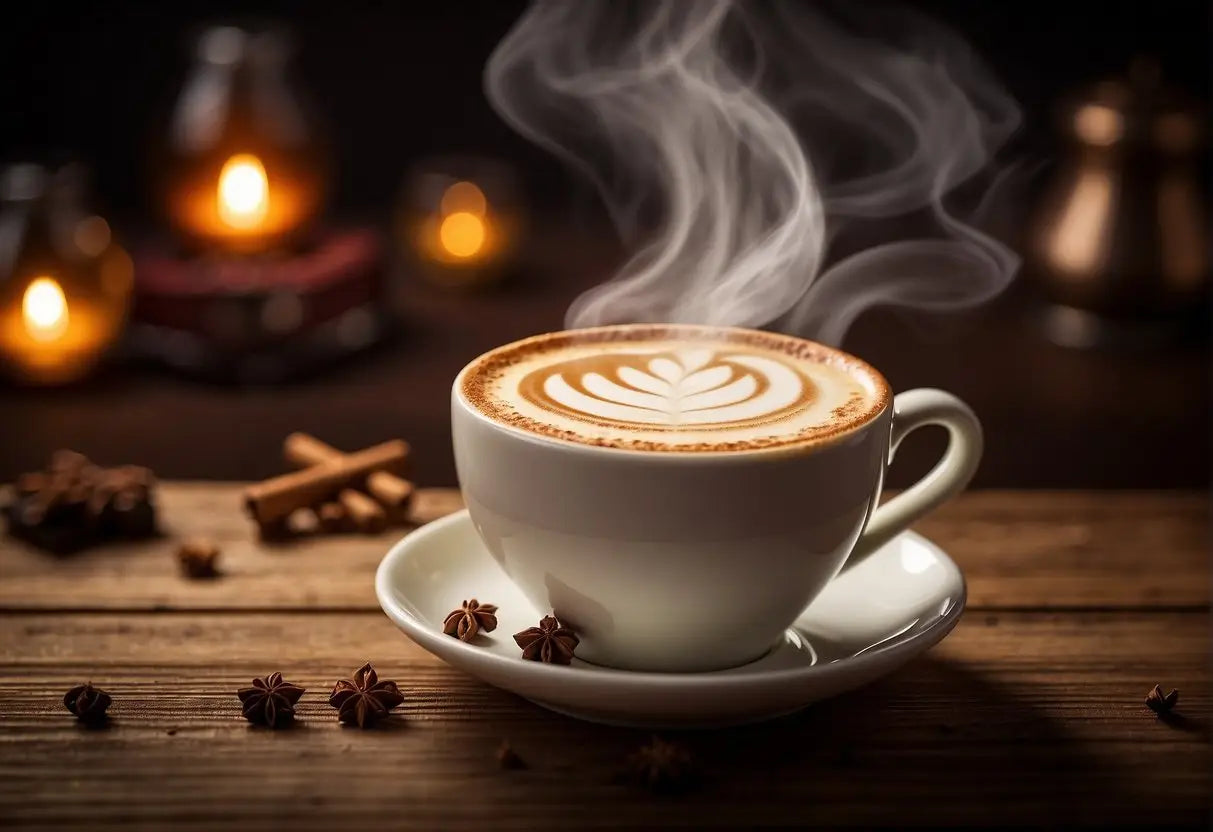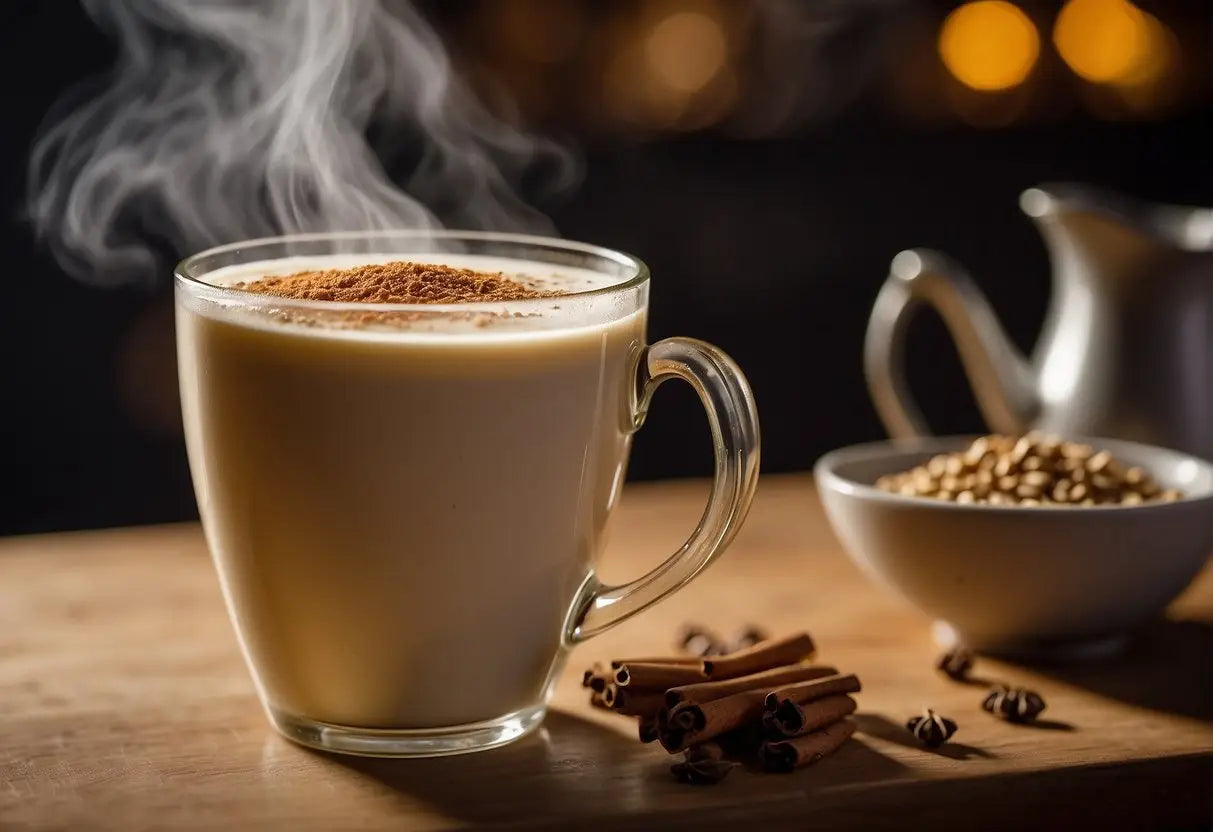What Does Chai Tea Latte Taste Like
Chai Tea Latte combines the warm spiciness of traditional Indian chai with the creamy richness of a latte. When you take a sip, your palate is greeted by a symphony of flavors:
- Sweetness: Often derived from sugar or honey.
- Creaminess: Thanks to the milk or milk alternative.
- Spiciness: A result of various spices.
Here are the key spices typically found in a Chai Tea Latte:
- Cinnamon: Adds warmth and sweetness.
- Cardamom: Contributes a slightly spicy and citrusy note.
- Ginger: Provides a zesty kick.
- Cloves: Offers a sharp, pungent taste.
- Black Pepper: Introduces a subtle heat.
- Star Anise: Adds a licorice-like flavor.
Underneath these spices, you'll notice the tannic and earthy notes of the black tea, which serves as the latte's base. The specific taste of your Chai Tea Latte can vary based on the type and quantity of spices used, as well as the choice of sweetener and milk.
Bestsellers
Texture also plays a part in the experience. A well-made Chai Tea Latte is:
- Frothy: From the steamed milk topping.
- Smooth: A result of the milk and tea blend.
Remember that the balance between the spices, tea, and milk components is crucial for an enjoyable cup. Your perfect Chai Tea Latte might differ from another's, depending on your preferences for sweetness, creaminess, and spiciness.
Key Ingredients

When crafting your chai tea latte, you'll blend a series of aromatic ingredients. These infusions are what give the chai tea latte its distinctive flavor profile.
Tea: The foundation is black tea, rich in flavor, often Assam or Darjeeling. Milk: Creamy milk, steamed or frothed, adds a smooth texture. You can use whole milk for richness or alternatives like almond, soy, or oat for different nuances.
The spices, each adding their unique notes, typically include:
- Cardamom: Sweet and spicy, cardamom is a quintessential chai spice.
- Cinnamon: Warm and woody, cinnamon offers a comforting sweetness.
- Ginger: With its sharp, peppery bite, ginger energizes the blend.
- Cloves and Black Pepper: These spices contribute a deep warmth and a mellow spiciness.
Sweeteners balance the spice intensity. Commonly used are:
- Honey
- Sugar: White, brown, or even the caramel notes of raw sugar.
- Syrups: Vanilla or caramel syrup can add another layer of flavor.
Finally, consider a pinch of salt to enhance the flavors and a dash of vanilla extract for a subtle, fragrant background note. Each element is essential in delivering the complex, satisfying taste of your chai tea latte.
Variations in Taste by Preparation Method

When you prepare a chai tea latte, the taste can vary greatly depending on the ingredients and the method of preparation you choose.
Classic Stovetop:
- Spices: A traditional chai made on the stovetop with whole spices offers a rich and complex flavor.
- Milk: Full-fat milk leads to a creamier taste while non-dairy alternatives can change the flavor profile subtly.
- Sweetness: Sugar or honey impacts the overall sweetness and can bring out the spices' nuances.
Example:
Lao Ban Zhang
- Spices: Cardamom, cinnamon, cloves, ginger
- Milk: Cow's milk or almond milk
- Sweetener: Cane sugar or honey
Instant Mixes:
- Convenience: Pre-packaged mixes tend to have a more uniform and consistent taste, but less depth.
- Additives: Often contain preservatives and additional flavoring that may alter the authentic chai taste.
Example:
- Instant chai powder mix
- Hot water or milk of your choice
- No additional sweeteners needed
Using Tea Bags:
- Strength: The strength of flavor in tea bags can be controlled with steeping time.
- Spices: Generally contain ground spices, which can result in a less vibrant taste compared to whole spices.
Example:
- Chai tea bag
- Hot water
- Milk and sweetener to taste
Table Summary:
| Method | Spices | Milk Option | Sweetener |
|---|---|---|---|
| Classic Stovetop | Whole spices for rich flavor | Full-fat or non-dairy | Sugar or honey |
| Instant Mixes | Uniform taste, less depth | Hot water or any milk | Often included in the mix |
| Using Tea Bags | Controlled by steeping time | Hot water then add milk | Optional, to taste |
Each preparation method can significantly influence the final taste of your chai tea latte, from the intensity of the spices to the sweetness and creaminess of the beverage. Choose based on your taste preferences and the experience you seek.
Influence of Spice Blend on Taste

When you sip a chai tea latte, the first sensation is often the warm and aromatic spices that characterize this popular beverage. This unique taste comes from a blend of spices that typically includes cinnamon, cardamom, cloves, ginger, and black pepper. Here's how each spice contributes to the overall flavor profile:
- Cinnamon: Adds a sweet and woody flavor, bringing warmth and comfort to your palate.
- Cardamom: Imparts citrusy and floral notes, providing depth and complexity.
- Cloves: Give a bold and piquant taste, which can be intensely aromatic.
- Ginger: Provides a pungent and spicy kick, soothing for digestion.
- Black Pepper: Adds a subtle heat and sharpness, enhancing the other flavors.
Proportions Matter The proportions of these spices can greatly influence the final taste of your chai latte; more cinnamon can make it sweeter, whereas additional ginger can increase the spiciness. Likewise, the coarseness of the spice grind will affect both the intensity and the release of flavors in the brew.
Freshness is Key Using freshly ground spices can significantly elevate the flavor of your chai tea latte. Pre-ground spices may result in a more muted flavor due to loss of essential oils over time.
By understanding the role of each spice, you can personalize your chai tea latte to your taste preferences, finding the perfect balance that delights your senses.
Comparisons to Other Beverages

When you sip a chai tea latte, you're experiencing a flavor profile that is warm and spicy, typically marked by notes of cinnamon, cardamom, cloves, ginger, and black tea. The addition of steamed milk smooths out the spice to create a creamy beverage. Here's how it compares to other popular drinks:
-
Coffee Latte: Lattes have a distinct coffee flavor, which is more bitter and less spicy than chai. While both drinks are milky, a chai latte offers a complex bouquet of spices that a coffee latte lacks.
-
Green Tea Latte: This latte is usually more vegetal and lighter, with subtle astringency from the green tea, contrasting with the bold, sweet spices of a chai tea latte.
-
Hot Chocolate: Despite also being a milky drink, hot chocolate is decidedly sweet with rich cocoa flavors, lacking the spice kick you’ll find in a chai latte.
Here's a quick rundown to compare:
| Beverage | Primary Flavors | Spice Level | Sweetness | Milk Content |
|---|---|---|---|---|
| Chai Tea Latte | Cinnamon, Cardamom | High | Moderate | High |
| Coffee Latte | Coffee, Espresso | None | Can vary | High |
| Green Tea Latte | Vegetal, Green Tea | None | Low | High |
| Hot Chocolate | Chocolate, Cocoa | None | High | High to Medium |
You'll find a chai tea latte to be a comforting, medium-sweet drink that stands apart with its distinctive combination of spices, compared to the more singular flavors of these other popular beverages.
Texture and Consistency

When you take a sip of a chai tea latte, you'll notice its smooth and creamy consistency. This texture is a result of the frothed milk that blends with the brewed chai tea. The milk, which is often whole milk for richness, is steamed to a warm temperature, introducing air into the milk and creating a dense foam.
- Steamed Milk: The body of the latte is velvety, enabling the drink to coat your palate pleasantly.
- Foam: A thin layer of microfoam tops the beverage, adding a subtle lightness.
Whole milk provides the most luxurious mouthfeel, but alternatives such as soy or almond milk can offer a lighter texture, though the latter might not froth as thickly.
The chai spices, which typically include cinnamon, cardamom, cloves, ginger, and black pepper, may leave a slight graininess in texture, evidencing their natural origin. This texture contrasts the smoothness of the milk, providing a balanced sensory experience.
- Spices: The authentic spices can create a fine, barely-there sediment at the bottom of your cup.
Overall, your chai tea latte should have a harmonious blend of airy froth and a substantial yet silky base—a truly indulgent texture that makes each sip delightful.
Sweetness Level and Adjustability

When you savor a chai tea latte, you'll notice its distinctive sweetness. This sweetness primarily stems from the sugar or sweetener added during preparation, alongside the natural sweetness of the chai spices. Depending on the recipe, the sweetness level can vary significantly.
- Pre-made Mixes: Often sweeter due to added sugars.
- Café Preparations: Sweetness can sometimes be adjusted on request.
- Homemade Lattes: You have full control over the sugar level.
Adjusting Sweetness:
Your chai tea latte's sweetness can be adjusted using different methods:
- Sugar or Honey: Adding more will increase sweetness, while reducing will lower it.
- Milk Choice: Full-fat milk tends to add creaminess and a subtle sweet edge; alternative milks like almond or soy often come sweetened, influencing the overall taste.
- Spice Blend: Increasing spices such as cinnamon or cardamom can enhance perceived sweetness without extra sugar.
Tips for Customization:
- Start with less sweetener and add to taste.
- Try sugar substitutes like stevia or monk fruit for a lower-calorie option.
- Experiment with spice levels to find your perfect balance.
Remember, your ideal chai tea latte might be different from someone else's. Don't hesitate to specify your sweetness preference when ordering out, or to experiment at home until you find your perfect cup.
Serving Temperature's Effect on Taste

When you enjoy a chai tea latte, the temperature at which it is served can significantly influence its flavor profile. A hot chai tea latte, typically served between 160°F to 180°F, allows the spices to release their full aroma, giving you a warm and comforting taste. The heat intensifies the sweetness of the milk and sugar, while bitterness from the tea is more noticeable at high temperatures.
-
Hot Chai Tea Latte:
- Pros: Full spice aroma, heightened sweetness.
- Cons: Increased bitterness, risk of scalding.
Conversely, an iced chai tea latte, often chilled to below 45°F, provides a refreshing experience. At this temperature, the spices may seem milder, and the sweetness is more subdued. If you're sensitive to the spiciness of chai, the cooler temperature can make the drink more palatable.
-
Iced Chai Tea Latte:
- Pros: Refreshing, mild spice flavor.
- Cons: Subdued sweetness, potential dilution from ice.
Room temperature chai, which is not as common, strikes a balance wherein the flavors meld subtly. The spices and tea's bitterness are less pronounced, and the drink may not seem as rich.
-
Room Temperature Chai Tea Latte:
- Pros: Balanced spice and sweetness.
- Cons: Less aromatic, potential loss of richness.
Your personal preference for temperature will determine which flavor experience you find most pleasing. It's worth experimenting with different temperatures to discover how they affect the taste and which suits your palate the best. Remember to consider not only flavor but also the texture and aroma, as these too are impacted by temperature.
Cultural Interpretations of Taste
In different cultures, the taste of a chai tea latte can be perceived in various ways due to unique palettes and traditions:
- India: You'll find chai as a robust, spiced, milky tea. It’s an essential part of daily life with strong flavors of cardamom, ginger, and clove.
- United States: Here, chai tea lattes are often sweeter and creamier, with a more subtle spice profile to appeal to the Western palate.
For example:
| Country | Typical Spices | Sweetness Level | Milk Type |
|---|---|---|---|
| India | Cardamom, ginger, clove | Moderate | Buffalo milk (traditionally used) |
| USA | Cinnamon, nutmeg, allspice | High | Whole or non-dairy milk alternatives |
When tasting a chai tea latte, your cultural background may influence your perception:
- If you're accustomed to bold spices, a chai latte might taste milder than expected.
- If your diet generally includes less spice, the same drink might seem unusually potent to you.
By understanding these cultural interpretations, you can better appreciate the various profiles of a chai tea latte. Enjoy discovering how the blend of spices, sweetness, and creaminess of milk can deliver a delightful and comforting experience, tailored to the tastes enjoyed around the world.
Dietary Variations and Their Impact on Flavor

When you explore the world of chai tea lattes, the type of milk and sweetener you choose can greatly influence the overall taste.
Milk Variations:
- Whole Milk: Rich and creamy, delivers a full-bodied texture.
- Skim Milk: Offers a lighter version, less creamy but enhances the spiciness of chai.
- Soy Milk: Adds a subtle nutty flavor with a smoother texture.
- Almond Milk: Imparts a naturally sweet, nut-like essence, thinner in consistency.
- Oat Milk: Provides a mild, sweet flavor with a creamy consistency similar to whole milk.
Each type of milk adjusts the latte's flavor profile and mouthfeel. Whole milk yields a decadent experience, whereas plant-based milks lend their unique tastes.
Sweetener Variations:
- Sugar: Adds a straightforward sweetness that can sometimes overshadow the chai spices.
- Honey: Offers a floral sweetness, complementing the warm chai flavors.
- Maple Syrup: Provides a rich, caramel-like sweetness with a touch of complexity.
- Agave Nectar: A mild, refined sweetness that doesn't compete with the chai's flavor.
The choice of sweetener is a key factor, as it can either enhance the chai spices or mute them. Honey and maple syrup are favorites for adding depth, while agave nectar maintains the chai's original flavor integrity.
Your chai tea latte may also include spices such as cinnamon, cardamom, cloves, ginger, and black pepper. The intensity and balance of these spices will react differently to the variety of milk and sweetener, influencing the final taste. Experimenting with these variables can help you discover your perfect flavor combination.
← Older post Newer post →











